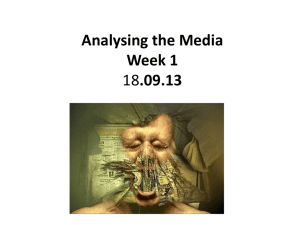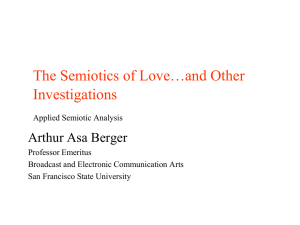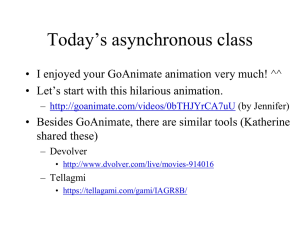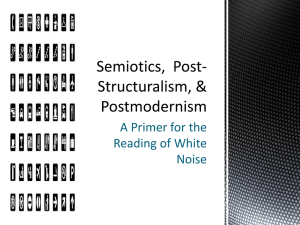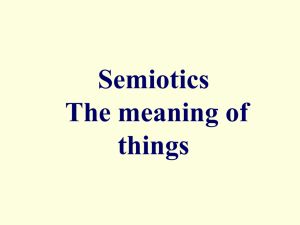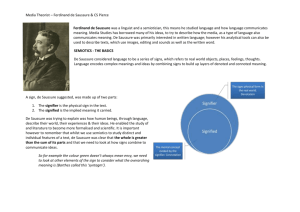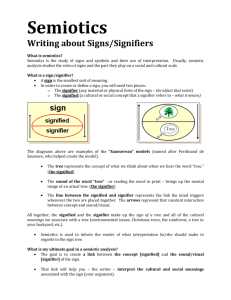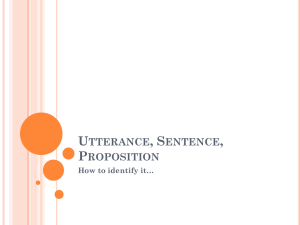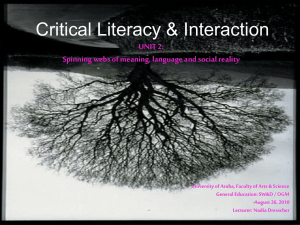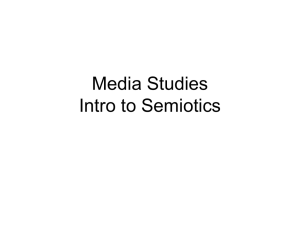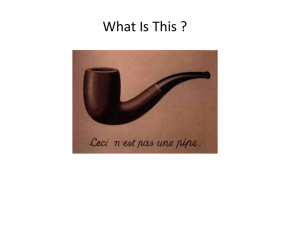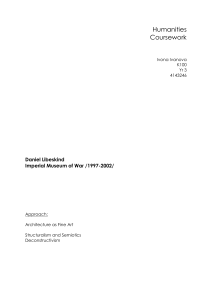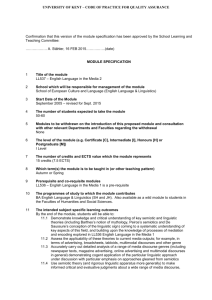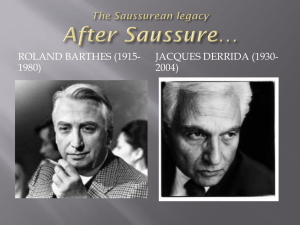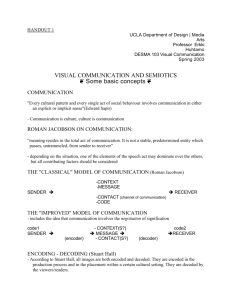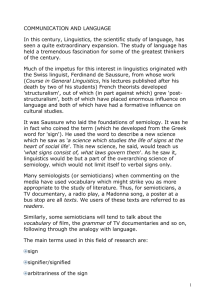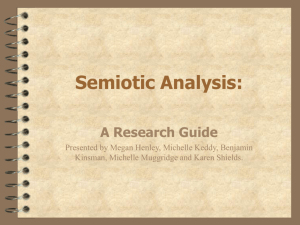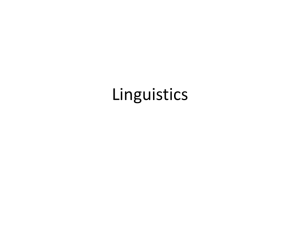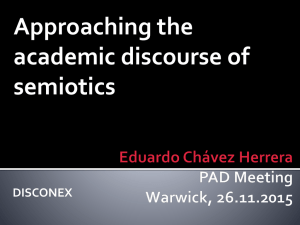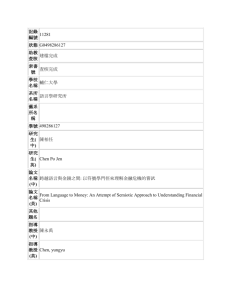sign - gra617
advertisement
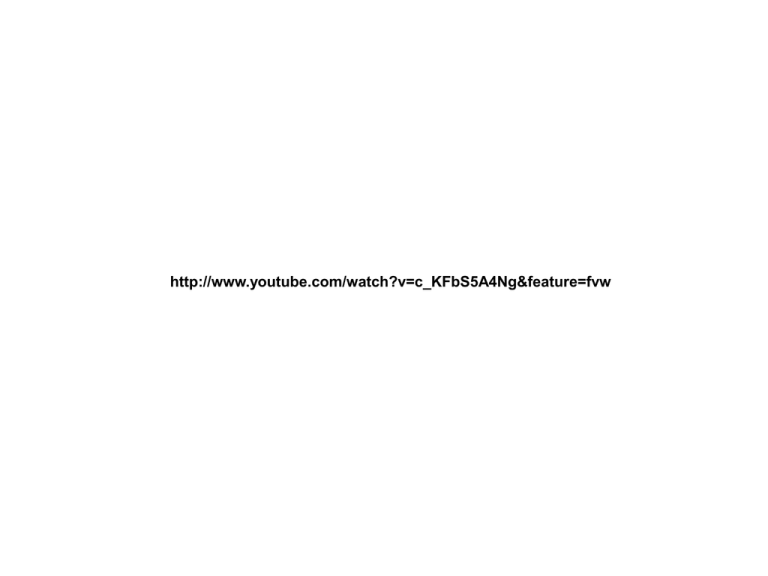
http://www.youtube.com/watch?v=c_KFbS5A4Ng&feature=fvw “I need a sign…” semiology (from the Greek semeîon, 'sign'): a science which studies the role of signs as part of social life. “Sign, sign, everywhere a sign…” COMMUNICATION THEORY Information theory in the late 1940’s: Intentional information = signal •“Cybernetics, or Control and Communication” Norbert Wiener •“A Mathematical Theory of Communication” Claude Shannon Crawford Dunn • Applies idea of signal to the content of messages • This idea lets us focus on the possible layers of meaning within a message SEMIOTICS Also called semiology The study of signs or sign systems. It applies to any kind of signs, not just words. Coined in 1690 by John Locke in “An Essay Concerning Human Understanding”. Signs = words Signs = images Signs = sounds Signs = gestures Semiotics is important because it can help us not to take 'reality' for granted as something having a purely objective existence which is independent of human interpretation. It teaches us that reality is a system of signs. Studying semiotics can assist us to become more aware of reality as a construction and of the role we play in constructing it. Meaning is not 'transmitted' to us, we actively create it according to a complex interplay of codes or conventions of which we are normally unaware. Becoming aware of such codes is both inherently fascinating and intellectually empowering. We learn from semiotics that we live in a world of signs and we have no way of understanding anything except through signs and the codes into which they are organized. ABCDEFGHIJKLMNOPQRSTUVWXYZ1234567890 ABCDEFGHIJKLMNOPQRSTUVWXYZ1234567890 Through the study of semiotics we become aware that these signs and codes are normally transparent and disguise our task in ‘reading’ them. ABCDEFGHIJKLMNOPQRSTUVWXYZ1234567890 ABCDEFGHIJKLMNOPQRSTUVWXYZ1234567890 In defining realities, signs serve ideological functions. Saussure & Sanefski Darren with Swiss linguist Ferdinand de Saussure circa 1916 Structuralism is an analytical method which has been employed by many semioticians and which is based on Saussure's linguistic model. Structuralists seek to describe the overall organization of sign systems as 'languages‘. a 'signifier' - the form which the sign takes; the 'signified’ - the concept it represents. the sign - the whole that results from the association of the signifier with the signified The relationship between the signifier and the signified is referred to as 'signification'. -- Saussure American Charles S. Peirce shown w/Darren Sanefski – circa 1918 Rowland Barthes shown w/Darren Sanefski – circa 1975 Barthes (French social theorist), and Sanefski, applied semiotics to cultural studies; has been applied to psychoanalysis, aesthetics, communications, and anthropology. Semiotics and that branch of linguistics known as semantics have a common concern with the meaning of signs, but John Sturrock argues that whereas semantics focuses on what words mean, semiotics is concerned with how signs mean. Three possible layers of a message: Alphasignal • Hard data or primary facts of a communication • Alpha: denoting the primary message • The objective part of the message Parasignal • Aspects of communication that supports or amplifies the alphasignal. • “Para”: above or beyond Infrasignal • Content beneath the message that can reveal information about the creator. • “Infra”: below or within Three possible layers of a message: Alphasignal • Hard data or primary facts of a communication • Alpha: denoting the primary message • The objective part of the message ELEMENTS OF THE MESSAGE as defined by Crawford Dunn Three possible layers of a message: Parasignal • Aspects of communication that supports or amplifies the alphasignal. • “Para”: above or beyond ELEMENTS OF THE MESSAGE as defined by Crawford Dunn Three possible layers of a message: Infrasignal • Content beneath the message that can reveal information about the creator. • “Infra”: below or within ELEMENTS OF THE MESSAGE as defined by Crawford Dunn METASYMBOL Significance beyond meaning OPEN Signified: The thing represented (Concept) Signifier: What represents the signified (Mark/Sound) OPEN Semiotics deals with how meaning is formed. The fundamental unit considered in semiotics is the sign. Signified: The thing represented (Concept) Signifier: What represents the signified (Mark/Sound) Dog Chien (France) Perro (Spain) Cane (Italy) Hund (Germany) < historical evidence does indicate a tendency of linguistic signs to evolve from indexical and iconic forms towards symbolic forms. Symbol %@$#* Icon • Resembles the thing it represents • Examples: pictorial representation, photo, architect’s model of a building Icon “Visual Cues” “Visual Cues” Index • Indirect connection to the thing it represents • Examples: smoke, shadows Index Symbol • Arbitrary relationship between signifier & signified. • Interpreter understands the relationship through previous knowledge. • Example: words, +, &, ?, $ Metasymbol • Symbol whose meaning transcends the realm of one-to-one relationships. • Barthes defined this as “myth”— when a sign becomes imbedded with abstract concepts through history, culture, and tradition. • For some readers, religious & magical signs & symbols have these properties: Christian crosses, etc. Semiotics of Ribbons http://www.youtube.com/watch?v=rEgxTKUP_WI&playnext=1&list=PLA21C626278D32590
